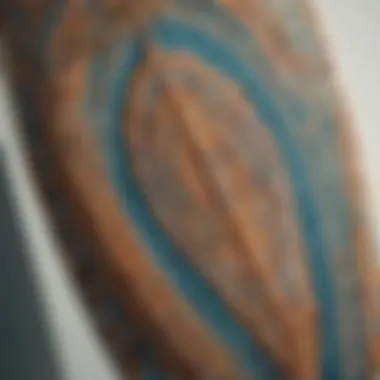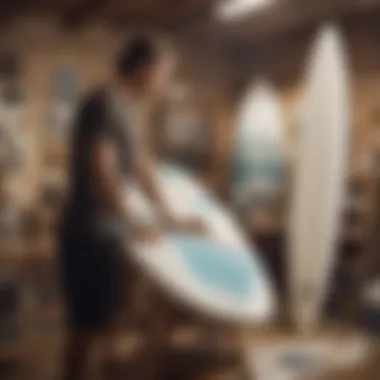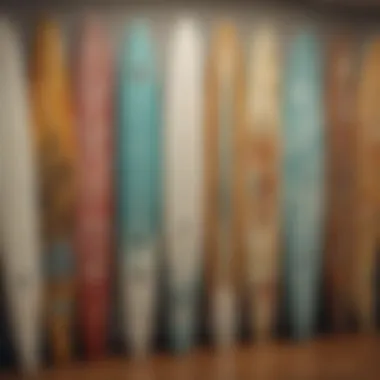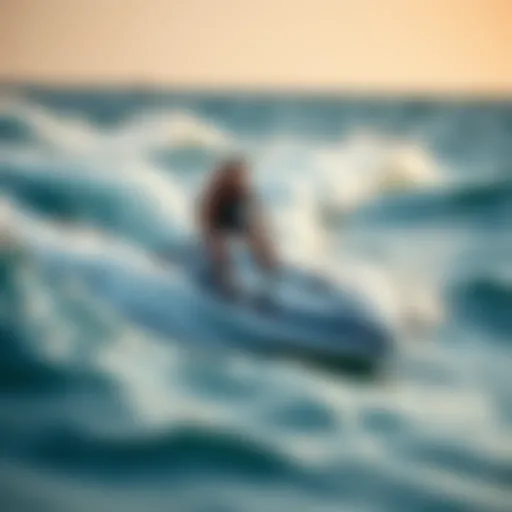The Art of Surfboard Paintings: A Cultural Perspective


Intro
The surfboard is more than just a tool for riding waves; it stands as a canvas where creativity clashes with the salty tide. Diving into the realm of surfboard paintings, this article seeks to sketch an intricate outline of how art and surfing intertwine, reflecting both individual expression and broader cultural narratives.
Many folks see surfboards purely as a means to an end—a vessel for catching waves. However, if you scratch the surface, you uncover a vibrant cultural tapestry woven from historical threads and personal stories. Surfboard painting transcends the ordinary; it's a unique form of self-expression shaped by various influences and practices. Artists pour their heart and soul into each stroke, turning these boards into rolling masterpieces that often reflect personal journeys or community bonds.
In the following sections, we will embark on a journey through time, exploring the historical significance of surfboard art, the craftsmanship that goes into each piece, and how contemporary artists are pushing boundaries. Along the way, we’ll delve into the individuality that shapes this form of expression, highlighting the communal dynamics that enrich this art form.
Stay tuned as we navigate through these waves of creativity, and perhaps discover how to catch our own.
The Historical Backdrop
Surfboard art isn't just a modern phenomenon. Its roots dig deep into the beach culture of the mid-20th century. Early board makers, originally from Hawaii, began experimenting with designs, symbolizing a merging of culture and craft. The introduction of vibrant colors and unique motifs not only served aesthetic purposes but also carried deeper cultural meanings often linked to local traditions.
As surfing gained popularity globally, so did the decorating of boards. From the psychedelic styles of the 60s to the more minimalistic designs of today, each era has left its stamp on surfboard art. This evolution reflects societal changes, emerging trends, and the ever-growing relationship between the surfer and their board.
"To me, painting a surfboard is like adding a part of myself to the wave I ride. It tells my story every time I hit the water."
— A passionate surfboard artist
The Craftsmanship Behind Surfboard Art
Creating art on surfboards is no small feat; it’s a labor of love that requires skill, patience, and a keen eye for detail. The materials used, such as epoxy resin and paint, withstand the rigors of ocean waves, sun exposure, and other elements. Therefore, the technique an artist employs becomes an essential part of producing durable artwork.
Some key elements of surfboard painting craftsmanship include:
- Sanding: Preparing the board to ensure the surface is smooth for painting.
- Priming: Applying a base coat that helps colors adhere better and pop visually.
- Designing: Sketching out or planning an intricate design that expresses personal or cultural significance.
- Painting: Applying color, whether it be through spray techniques or brushwork, to bring the design to life.
- Finishing: Coating with a sealant or resin that protects the artwork and enhances the gloss.
These steps highlight that surfboard painting is not merely a hobby but an intricate craft that intertwines art and engineering. Each colorful board tells a story—one that speaks of the waves, the culture, and the person riding it.
The Community Aspect
An often overlooked dimension of surfboard painting is the communal aspect it fosters. The art form serves as a bridge among surfers, artists, and enthusiasts alike. Local surf shops often become gathering spots where artists can showcase their work, surfboards can be swapped, and inspiration flows freely.
Moreover, social media channels, like Facebook and Reddit, have ushered in a new age for surfboard painters. Artists can share their creations, gain feedback, and collaborate, opening the door to a world of possibilities that transcends geographical limits.
In closing, the world of surfboard paintings is rich with history, craftsmanship, and community spirit. As we continue through this article, we’ll dive deeper into individual narratives and current trends that continue to shape this multifaceted art form.
Prelude to Surfboard Art
Surfboard art isn't just a splash of color on a piece of wood; it's a vivid expression of identity and creativity shaped by culture and personal history. The importance of this topic lies in its ability to tell stories—stories of places, cultures, and individuals who are unapologetically in love with the ocean. Exploring surfboard paintings means diving into a realm where aesthetics meets functionality, where the waves become more than mere water—it's about embracing a lifestyle, an attitude, and a community.
By understanding surfboard art, we grasp the nuances of how art can transcend traditional boundaries to infiltrate realms like sports and leisure. Moreover, surfboard designs are not merely decorative; they often incorporate elements that symbolize local heritage, natural beauty, or even social messages. Whether it's a vibrant wave pattern or a tribute to a cultural legend, these designs can serve as a canvas that reflects broader social dynamics.
Defining Surfboard Paintings
Surfboard paintings come in myriad styles, ranging from intricate freehand designs to digital prints. However, at their core, they are manifestations of personal expression paired with the functionality required for optimal performance on waves. Just as a painter uses a canvas, a surfer uses a board, and the surface becomes a playground for creativity.
Each surfboard painted is not just for aesthetic pleasure; they're often imbued with meanings and experiences tied deeply to the surfer's life and the culture of the surfing community. While talking about definitions, surfboard paintings integrate different art forms like street art, traditional painting, or even contemporary graphic design, showcasing the versatility that this genre offers.
The Fusion of Art and Sport
When we look at surfboard paintings, we see a unique blend of art and sport that doesn't simply coexist but thrives together. Surfers aren't just athletes; they are artists too. This fusion adds depth to the artistic process. For many, surfboards are not merely tools but rather personalized artworks that reinforce their individual styles on the waves.
The reflected images in surfboard art can evoke emotions, draw upon memories, and connect with collective cultural elements. Surf competitions often feature boards that not only prioritize performance but also possess artistic merit. Judges increasingly take into account the artistic appeal of the boards alongside athletic performance, illustrating how seamlessly both elements intertwine.
Art provides a narrative; it speaks to the relationship a surfer has with nature, their roots, and their community. From a practical standpoint, these designs can also influence visibility in the water—an interesting consideration that marries both aesthetic and functionality.
"Art is not just what you see, but what you make others see."
As we delve into the historical context and techniques used in surfboard painting, we unravel layers upon layers of stories and traditions intricately linked to this cultural phenomenon.
Historical Context
Understanding the historical context of surfboard paintings provides crucial insights into how this unique cultural expression has evolved over time. The art form is not merely a decoration; it is steeped in tradition and reflects the values, beliefs, and history of the communities that practice it. The roots of surfboard art can be traced back to indigenous practices, where art served as a medium of storytelling and cultural identity. By uncovering these beginnings, one can appreciate the intricate connection between surf culture and the artistic expressions that accompany it.
Early Beginnings of Surfboard Art


The early days of surfboard art are fascinating, illuminating a landscape where waves and wood came together in an unholy alliance of nature and creativity. Surfboards were not always the bright, vivid canvases they are today. Initially, these boards were crafted from solid wood and often left bare. The early surfers, particularly in Hawaii, began to etch and carve designs on their boards. This wasn't just decoration; these patterns often held spiritual significance or narrated a story.
Moreover, as the sport spread to other parts of the world, influences began to influx. For instance, in California during the late 1950s and early 1960s, surf culture underwent a transformation with the introduction of fiberglass boards. This made painting not just an option but a vivid opportunity to express individuality and surf identity. Away from the traditional motifs, surfers started to welcome psychedelic colors and abstract art as the surfing lifestyle integrated more into pop culture.
Cultural Significance in Indigenous Societies
In numerous indigenous societies, surfboard paintings hold substantial cultural significance transcending mere aesthetics. For them, these paintings represent more than just beauty—they symbolize respect for the ocean, ancestral heritage, and connection to the land. In Hawaii, for example, surfboard designs often showcase intricate geometric patterns and revered symbols that tell stories of the gods and spirits of the sea.
"Art reflects the cultural tapestry of a society, intertwining history, spirituality, and identity."
Moreover, surfboard art serves various communal purposes. It draws people together, forging bonds among surfers while simultaneously educating outsiders about their beliefs and heritage. As artists paint their narratives on surfboards, they not only maintain their traditions but also invite waves of new influences that keep their culture afloat. Indigenous painting techniques, like using natural pigments sourced from their environment, emphasize an ecological consciousness that still resonates in today's surf culture.
The evolution of surfboard art is an ongoing narrative, rooted in the early practices of indigenous societies and branching into contemporary expressions still rich with cultural significance. Understanding these historical dimensions enables modern artists and surfers to connect with a lineage that underscores the beauty of individuality while respecting the collective heritage of surf culture.
Techniques and Materials
In the captivating domain of surfboard paintings, the choice of techniques and materials looms large, shaping the final artwork in significant ways. The process of painting a surfboard transcends mere aesthetics; it is entwined with the surfboard's functionality and durability. For surfers and artists alike, understanding the subtle intricacies involved in these choices can be the difference between a vibrant masterpiece and a painting that withstands the test of time.
Choosing the Right Paint and Brushes
Selecting the appropriate paint is crucial in surfboard art. Not all paints are created equal, and using the right type can have a notable impact on appearance and longevity. When we talk about the right paint, we typically refer to polyurethane and acrylic paints. While polyurethane offers a robust finish that can endure the surf's relentless action, acrylic paints provide vivid colors but may require more frequent touch-ups.
Brushes are another integral element. Quality brushes help in achieving precision, particularly for intricate designs. For broad strokes, a wide-bristled brush may come handy, while finer brushes suit detailed work. Do not overlook the use of sponges or even airbrushes for blending colors and creating unique textures. Some artists will even mix solvents to achieve thickness and glossiness, which adds a professional touch to their designs.
"If you want your surfboard artwork to pop, think of your materials as the palette of an artist. You choose wisely, and the canvas will sing."
Some additional considerations include:
- Water Resistance: Since surfboards are constantly in contact with ocean water, selecting water-resistant paints is a must.
- Flexibility: Paints that allow for slight flexing without cracking should be prioritized, especially for performance boards.
- Eco-Friendly Options: As sustainability becomes important, consider using non-toxic and biodegradable paints without sacrificing durability.
Finishing Techniques: Epoxy vs. Polyester
Once the painting is complete, the choice between epoxy and polyester resin for finishing becomes a pivotal decision. Each offers distinct qualities that can affect both the durability and aesthetic of the surfboard.
Epoxy resin is often regarded as the superior option. Its main advantages include
- Strength: Epoxy is generally tougher than polyester, making it ideal for high-performance boards that are subjected to rough conditions.
- Lightweight: This type of resin is less dense, reducing the overall weight of the surfboard which can improve performance.
- UV Resistance: Epoxy resins exhibit greater resistance to ultraviolet light, which means the colors will not fade as quickly when exposed to sunlight.
On the other hand, polyester resin remains popular in surfboard art for a few reasons:
- Cost-Effectiveness: It is usually cheaper and widely available, making it a go-to choice for many surfboard artists.
- Simplicity: Polyester is easier to work with for beginners, allowing them to achieve a decent finish without extensive experience.
- Long-Lasting Shine: It often gives a more glossy, glass-like finish, which can enhance the visual appeal.
Both options have their pros and cons, and in the end, the choice may boil down to personal preferences and the specific goals of the artist. Ultimately, understanding these techniques and materials not only catalyzes better artwork but can also elevate the entire surfing experience. Each brush stroke, every color choice, is a reflection of the artist’s identity, and their understanding of materials plays a critical role in this expressive journey.
Personalizing Your Surfboard
Personalizing a surfboard is much more than slapping on a few vibrant colors; it's an exploration of identity, creativity, and connection to the waves. Your surfboard is a canvas reflecting who you are, echoing your journey and preferences within the surfing community. This section delves into what makes customizing a surfboard so significant, highlighting specific elements that cater to individual expression and community ties.
Incorporating Personal Themes and Stories
Each stroke of paint on a surfboard embodies personal tales waiting to be told. The designs can represent memories, passions, or even family traditions. For instance, a surfer may choose to include local motifs, such as the outline of their home beach or famous local wildlife. These themes speak to a shared experience, inviting dialogue and connection among fellow surfers.
Here are a few notable aspects to consider when incorporating personal stories into your surfboard design:
- Cultural Heritage: Symbols and patterns that reflect your cultural background can turn a surfboard into a storytelling medium. Whether it’s tribal designs or regional motifs, these choices connect to your roots.
- Personal Experiences: Everyone has a tale. Did you have an unforgettable surf trip? Capturing that in art allows the essence of those moments to ride the waves with you.
- Passion Projects: Love for marine wildlife might inspire a surfboard adorned with intricate ocean creatures or coral motifs, promoting awareness and respect for the ocean.
Embracing your narrative through art not only transforms the surfboard but also conveys a deeper message to others.
Selecting Colors and Patterns
The choice of colors and patterns can ignite emotions and set a tone before even hitting the water. Different colors evoke various feelings—blue can remind you of calmness, while vibrant reds might stir excitement. Choosing the right combination depends on what you want to express:
- Neighborhood Vibes: Local surf culture can heavily influence choices. A surfer in California might lean towards bright yellows and oranges reflecting the sunny beaches, while someone from the Pacific Northwest may channel earthy tones, reminiscent of the ocean's powerful depths.
- Artistic Styles: From abstract designs to geometric patterns, the artistic choice can allude to traditional art forms or personal aesthetic. Each selection becomes a reflection of the surfer's personality and artistic taste.
- Trends vs. Individual Expression: While it’s easy to get swept up in current trends, it is crucial to select patterns that resonate with your identity as a surfer. Authenticity shines through when mismatched with popular culture.
In summary, personalizing your surfboard lays down an artistic narrative that intertwines with your surf experiences. A well-thought-out design can articulate individuality and foster community connections, elevating every ride into an expression of self.
Contemporary Influences


The realm of surfboard art is an ever-evolving tapestry, intricately woven with the threads of contemporary culture. This section sheds light on how present-day influences shape the world of surfboard paintings, from the artists pushing boundaries to the digital communities fueling creativity. Embracing these influences not only enhances the artistic landscape but also preserves the cultural significance found in every brushstroke.
Modern Artists and Designers in Surfboard Culture
Today’s surfboard artists and designers are akin to pioneers navigating uncharted waters. A diverse array of voices enriches this field, each adding their unique flair to the surf culture. Artists like Pablo Ramirez, renowned for his intricate designs depicting ocean landscapes, use surfboard canvases as extensions of their artistic vision. Another contemporary figure is Ashley K., who has merged traditional Indigenous art elements with modern aesthetics.
These creators often explore themes such as environmental consciousness and personal storytelling, thus making their work resonate on multiple levels. Their surfboard paintings become more than just functional tools; they stand as powerful artworks celebrating identity and perspective.
Unfortunately, not every artist gets the recognition they deserve. While some names are splashed across magazines, many skilled individuals create stunning art quietly behind the scenes, waiting for their moment in the spotlight. In a world flooded with visual content, it’s essential to sift through and appreciate the unsung talent that fuels this vibrant movement.
Influence of Social Media and Online Communities
The emergence of social media has further propelled surfboard art into the mainstream, transforming how both artists and enthusiasts engage with each other. Platforms like Instagram and Reddit serve as virtual galleries, showcasing surfboard designs and offering insights into the creative process.
Artists can share their works with the click of a button, instantly gaining visibility among a global audience. The accessibility of these platforms fosters collaboration, where diverse artists can share their techniques and ideas.
On forums like Reddit’s surf community, enthusiasts discuss trends, share experiences, and offer constructive feedback. This interaction helps forge a stronger sense of community, encouraging emerging artists to refine their craft and contribute fresh perspectives. Reinforced by online activism, surf communities have also tackled pressing issues, such as ocean pollution, emphasizing the role of art as a means of raising awareness.
"Art is not just a visual experience; it's a conversation that transcends borders. In surfboard painting, this conversation is alive and thriving."
Though social media can show unwavering comparisons, it’s important for artists to focus on self-expression beyond likes and shares. Emerging traditions within digital collaboration continue to mold how surfboard art evolves, ensuring that it remains both relevant and impactful.
In summary, contemporary influences in surfboard painting encapsulate a rich tapestry of modern artists’ perspectives and the collaborative environment fostered by social media. This interplay not only breathes new life into an already vibrant art form but also encourages inclusivity, dialogue, and creative expansion.
The Role of Surfboard Art in Competitions
Surfboard art doesn't just serve as a canvas for individual expression; it plays a vital role in competitions that celebrate both surfing and artistic prowess. Competitions aren’t just about catching the perfect wave; they're also about showcasing creativity and innovation on the surfboard. In many instances, the way a board is painted can enhance its aesthetic appeal and influence a judge's perspective on the overall performance.
Artistic considerations add layers of complexity to surfboard competitions, transforming them into platforms that highlight cultural and personal narratives. The importance of surfboard paintings in these events goes beyond just being visually appealing; they represent the spirit and identity of the surfer, often reflecting their local culture, experiences, or even environmental concerns.
Judging Criteria for Artistic Appeal
When it comes to evaluating surfboard art in competitions, judges look for a range of artistic qualities that can set a piece apart. Among these criteria are:
- Originality: How unique is the design? Originality often speaks to the soul of the artwork, differentiating it from the crowd.
- Technique: The skill involved in creating the artwork matters significantly. This includes brushwork, paint application, and materials used.
- Relevance: Does the artwork resonate with the surfing community or address broader themes? Judges often value pieces that tell a story or convey a message.
- Color and Composition: The choice of colors and overall layout can enhance the visual impact. Harmonious blends and striking contrasts often attract favorable attention.
Each of these elements contributes to the overall perception of a surfboard's artistic merit and, consequently, the judges' final score.
"Art on a surfboard doesn't just decorate; it narrates. It tells tales of culture, identity, and environmental awareness."
Noteworthy Events Showcasing Surfboard Art
Several events around the globe focus on surfboard art, turning competitions into vibrant celebrations of creativity. Some noteworthy events include:
- The Boardroom International Surfboard Show in California, where surfboard art takes center stage, attracting artists and surf enthusiasts alike.
- The X Games occasionally feature competitions that combine surfing performance and artistic excellence, blending athleticism with creativity.
- Local Surf Festivals often have categories for artistic boards, shining light on emerging artists and local talent.
These events foster a sense of community, and together they emphasize the significance of surfboard art within the surfing culture. Competitors often interact with bodies of work from seasoned artists and new challengers alike, engaging in meaningful exchanges that can enrich their own practices.
Expressions of Identity and Community
The intricate world of surfboard paintings serves as a canvas where not only artistic flair but deep-seated identity and community values intersect. Surfboards are not merely floatation devices; they embody personal stories, cultural backgrounds, and a collective sense of belonging. Surfers from diverse backgrounds utilize this medium to express the narratives tied to their identities, making each board a reflection of the person behind it.
How Surfboard Paintings Foster Connections
Surfboard paintings bring together individuals, creating a tapestry of shared experiences. Through vibrant colors and intricate designs, surfers communicate not just personal aesthetics but also broader connections with their communities. This artistic exchange fosters camaraderie among surfers. When a surfer showcases their uniquely painted board, it becomes a conversation starter, a bridge that links them with fellow enthusiasts.
- Sense of Belonging: Painted surfboards embody collective identity. The designs often resonate with local culture, traditions, or events. When surfers share these boards, they create a sense of belonging within their surf community.
- Collaboration: Often, individual artists and surfers collaborate in creating these designs. This leads to a mingling of styles and influences, further blurring the lines between personal identity and communal expression.
- Shared Spaces: Surf competitions and local beaches often become galleries that showcase these painted boards. This visibility cements community ties and shows off the rich diversity that exists within surf culture.
In all these ways, surfboard paintings nurture connections. They carry stories that resonate with the broader surfing community, emphasizing shared values and highlighting the cultural elements fundamental to the surf experience.
Art as a Medium of Resistance and Voice
Beyond mere decoration, surfboard art can act as a powerful medium of resistance. In a world where social and environmental issues often feel overwhelming, these artistic expressions frequently convey protest, resilience, and a call for change.
Surfers have long been vocal advocates for ocean conservation, cultural preservation, and social justice. Through their art, they often use their boards as canvases to voice dissent or to highlight key issues. Some significant ways that surfboard paintings serve this purpose include:
- Messages and Themes: Many artists embed strong messages into their designs. From environmental degradation to indigenous rights, these artworks may convey powerful narratives that urge viewers to reflect on pressing societal concerns.
- Raising Awareness: When a surfer takes their painted board into the ocean, they are not just surfing but also taking a stand. The visibility of such boards raises awareness around issues that might otherwise remain hidden in traditional media.
- Empowerment: Many artists claim their right to express through their boards, breaking away from mainstream norms. This act of defiance can empower artists and surfers alike, encouraging them to boldly share their stories.


Art transforms personal experiences into shared concerns, allowing individual voices to be heard within the larger narrative of surf culture.
Environmental Considerations
When discussing surfboard paintings, it’s crucial to consider the environmental impact of both the materials used and the messages conveyed through art. As surfing gains popularity, so does the scrutiny surrounding the sustainability practices of the associated industries. Surfboard art is not just about aesthetics; it intertwines with broader ecological themes and reflects an awareness of our planet's health.
Sustainable Materials for Surfboard Art
Choosing the right materials for surfboard art can make a significant difference in minimizing one’s environmental footprint. Traditional surfboard crafting often relied on materials that are not eco-friendly, leading to pollution and waste. However, artists and manufacturers are shifting towards sustainable options, pushing the envelope on innovation.
Some sustainable materials being explored are:
- Epoxy Resins: Unlike standard polyester resins, epoxy is generally more durable and emits fewer volatile organic compounds (VOCs) during curing.
- Bio-Based Fibers: These fibers originate from organic materials, lessening reliance on fossil fuels. Natural fibers, such as hemp or flax, deliver strength while being biodegradable.
- Recycled Plastics: More surfboards are being crafted from recycled materials, which reduces landfill waste.
Using such materials not only supports the environment but also aligns with the growing advocacy for eco-consciousness within the surfing community. The marriage of sustainability with artistic expression enhances the cultural narrative of surfboard art, making it a statement on personal and collective responsibility.
Impact of Art on Environmental Awareness
Art has always served as a medium for raising awareness about pressing issues. In the realm of surfboard painting, artists often incorporate environmental themes within their work, pushing audiences to engage with critical ecological matters. A unique design on a surfboard can be more than just visual appeal; it can resonate with deeper messages concerning climate change, ocean health, and species preservation.
Artists have the ability to articulate this awareness through:
- Visual Storytelling: Art can capture the stark reality of environmental degradation or the beauty of nature, creating a juxtaposition that prompts reflection among viewers.
- Social Commentary: Many designs showcase symbols or narratives that underscore the urgency for environmental action, appealing to the surf community's collective ethos.
- Community Engagement: Collaborations with environmental organizations or sponsorship of surf competitions centered around environmental causes link artists directly with activism.
As surfboard art continues to evolve, fostering a culture of awareness and action is paramount. By embedding messages of environmental mindfulness into their canvases, artists can inspire surfers and audiences alike to consider their role in the ongoing dialogue about the natural world.
"Art enables us to find ourselves and lose ourselves at the same time." - Thomas Merton
Future Trends in Surfboard Art
The world of surfboard art is constantly shifting, much like the tides that surfers ride. As culture evolves, so too does the way surfboards are painted and personalized. Understanding these future trends is vital for both enthusiasts and artists, as they shape not only the aesthetics of surfboards but also how communities interact with and value this form of expression. Each trend not only reflects changes in artistic techniques but also a deeper commitment to the culture of surfing and its environmental implications.
Technological Advances and Digital Art
The advent of technology has taken the realm of surfboard painting by storm. With the introduction of digital design tools, artists now have an array of new possibilities at their fingertips. Programs like Adobe Illustrator and Procreate allow for intricate designs that were cumbersome to create by hand. These platforms enable artists to experiment with colors, patterns, and textures in ways that were previously unimaginable.
Moreover, 3D printing technology is beginning to play a role in surfboard art, offering opportunities for unique, custom-shaped designs that can blend seamlessly with artistic elements. This shift to technology does not replace traditional techniques but rather enhances them, creating a hybrid style that embraces modernity while respecting the old-school vibes.
Here are a few key benefits of incorporating digital art into surfboard painting:
- Precision: Digital tools allow for meticulous designs that exactingly match the artist's vision.
- Speed: The ability to quickly iterate on designs saves time, particularly for commercial artists.
- Accessibility: New programs make it easier for aspiring artists to break into the field, leveling the playing field with established creators.
- Innovation: Artists can blend traditional techniques with digital methods, creating a unique blend of styles that attract contemporary surfers.
As these technologies develop, we can expect to see even more innovative approaches emerge in surfboard art, pushing boundaries of what the art form can achieve.
The Growth of Customization in Surf Culture
Customization has become the name of the game in surf culture, elevating the idea of a personalized surfboard to new heights. Individuality seems more valued than ever with influences from global art movements spilling over into local surf scenes. Surfboards are no longer just tools for riding waves; they have transformed into canvases that express the identity and stories of their owners.
As this trend takes hold, several factors are driving the demand for custom surfboard art:
- Self-Expression: Surfers are looking to distinguish themselves and reflect their personality through unique artwork.
- Localism: Many surfers want to support local artists, commissioning designs that resonate with their community's culture.
- Custom Services: Companies are increasingly offering personalized services where surfers can collaborate directly with artists on designs.
- Merchandising: Custom surfboards can attract higher prices, making them financially appealing for artists and craftsmen alike.
In this environment, artists are finding a bountiful source of inspiration from the communities they engage with. They are painting not just for profit but also to foster a sense of connection among surfers. This more personalized approach is reshaping surf culture, emphasizing creativity and community as pivotal components of the surfing experience.
"The only limits in surfboard art are the depths of the artist’s imagination."
As we navigate through these waves of change, it becomes clear that the future of surfboard art lies in the synergy between technological advancements and the craving for individual expression. These evolving trends affirm that while surfboards may change in form, the cultural significance behind them remains as vibrant as ever.
End: The Enduring Legacy of Surfboard Paintings
The world of surfboard paintings is not just a visual spectacle but a rich tapestry interwoven with history, culture, and individual identity. As we wrap up this exploration, it’s essential to consider how the legacy of surfboard art continues to impact both surf culture and the broader artistic community. These artworks are not merely decorative; they carry narratives and emotions that resonate with surfers and artists alike. Through creativity, surfers know not only to ride waves but to also express themselves on a personal canvas that glides across the ocean.
Reflection on the Evolution of Surfboard Art
Surfboard art has seen significant evolution since its inception. Originally, surfboards were quite utilitarian—designed for function over form. However, as surfing gained popularity, so too did the motivation to beautify and personalize these essential tools. For instance, the bold graphics and bright colors of the late 20th century reflected the surf culture’s growth and recklessness of youth. Today, a diverse range of styles emerges from artists who explore themes from ocean conservation to cultural heritage. The surfboard emerges as a canvas that tells the story of the surfer’s journey, both literally and metaphorically.
It’s fascinating to consider how social media platforms serve as a museum of the modern-day surfboard art. Instagram accounts showcase intricate designs and the processes behind them. New trends continually bubble up, presenting a fusion of styles merging traditional techniques with modern graphics. The global reach of the internet has allowed artists from remote corners of the globe to present their work, making the surfboard art community more vibrant and diverse than ever.
Encouraging New Artists in the Surfing Community
With the flourishing scene, it’s also vital to cultivate and encourage new artists within the surfing community. Workshops and collaborative events can demystify the creative process, offering beginners opportunities to engage with experienced artists. Resources such as community art classes or social media pages dedicated to surfboard painting can provide not just guidance but also a sense of belonging among aspiring artists.
"Art is what makes life livable. Just as waves shape the shoreline, art shapes cultures."
Local surf shops too can play a role in this, by hosting art exhibitions that spotlight emerging talents. These platforms foster local pride and encourage a cycle of creativity that keeps surfboard painting bold and fresh. Soliciting designs from new artists for competitions can harness the community's innovative spirit to breathe life into the identity of surfing.
In this way, the enduring legacy of surfboard paintings serves as a reminder that art does not exist in isolation; it thrives within the community of those who cherish the ocean, the sport, and the stories etched on their ride. Surfboard art will continue to reflect personal journeys and collective identities, ensuring it remains relevant for generations to come.















